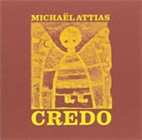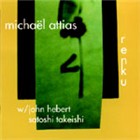Home » Jazz Articles » Profile » Micha
Micha
 Paris has always been a haven for musicians. In the late 1980s a stream of jazz greats passed through the bar at Alan Silva's music school where saxophonist Michaël Attias manned the tap. "I remember pouring [saxophonist] Frank Wright a beer two weeks before he died, he recalled. "Sunny Murray, Jerome Cooper, Abbey Lincoln rehearsing...I remember her eyes... what a beautiful presence. At the time, many of the musicians discussed the work they had done in the 1960s, with reluctance. "It was kind of like a shameful secret. I felt that. But the climate has changed, he explained, noting how a revival in styles these players had developed, later emerged.
Paris has always been a haven for musicians. In the late 1980s a stream of jazz greats passed through the bar at Alan Silva's music school where saxophonist Michaël Attias manned the tap. "I remember pouring [saxophonist] Frank Wright a beer two weeks before he died, he recalled. "Sunny Murray, Jerome Cooper, Abbey Lincoln rehearsing...I remember her eyes... what a beautiful presence. At the time, many of the musicians discussed the work they had done in the 1960s, with reluctance. "It was kind of like a shameful secret. I felt that. But the climate has changed, he explained, noting how a revival in styles these players had developed, later emerged. Attias ponders the relevancy of the past a lot these days. He recently played with drummer Paul Motian for the first time during a recording session for an album with the Terumasa Hino/Masabumi Kikuchi Quintet, set for release this fall, and found the modernity of the drummer's playing particularly striking. "His records from the 1970s sound like they were done a couple of weeks ago, he said. "They seem very current. I think the past changes in that way. What's useful from it changes. Certain things come back. Time is not linear, especially not in art. Charlie Parker constantly comes back in different ways for me.
Names like Charlie Parker were unknown to Attias until the day he discovered a copy of Nat Hentoff's Jazz Is on the library shelf at his elementary school in Minneapolis, where he moved with his parents from Paris at age eight. Intrigued by photos and stories about John Coltrane, Cecil Taylor, Sonny Rollins, Thelonious Monk and Ornette Coleman, he began to seek out their music and at fifteen, around the time he discovered Coleman's The Shape of Jazz To Come (Atlantic, 1959), he started playing the saxophone.
Born in Israel to Moroccan parents, Attias grew up in Paris and Minneapolis. When the first track on the album, "Lonely Woman began to play, a lot of things started to make sense. "It sounded like the music of my childhood, he said. "It sounded completely North African. Charlie Haden sounded like an oud. It seemed so un-Western, so much closer to the way my grandfather sang in the synagogue.
Last June [2007], Attias actually played with Coleman. A pianist he met at Masabumi Kikuchi's house invited him to join a jam session. "He was so beautiful. He really lives, breathes and speaks like his music. I've never been so impressed with a sense of somebody knowing exactly what they're doing and being so free because of that.
 The session helped validate a concept of letting go that Attias had lately been contemplating. "There was a period when shedding meant two things. It meant going to the woodshed to practice, but it also meant shedding a layer of yourself. Somebody like Coltrane didn't play like he played in 1957 in 1964. Once he had done that he left it behind him. But I think we're in a different time now. We want everything to be available to us, to play like this one moment and this another and it's a beautiful thing this eclecticism, but it's a dangerous thing too, we lose that sense of shedding, really letting go of things.
The session helped validate a concept of letting go that Attias had lately been contemplating. "There was a period when shedding meant two things. It meant going to the woodshed to practice, but it also meant shedding a layer of yourself. Somebody like Coltrane didn't play like he played in 1957 in 1964. Once he had done that he left it behind him. But I think we're in a different time now. We want everything to be available to us, to play like this one moment and this another and it's a beautiful thing this eclecticism, but it's a dangerous thing too, we lose that sense of shedding, really letting go of things. Six years after Attias recorded his sextet album Credo, Clean Feed released it in 2005. He had composed all eight tracks. "It was really someone else's music. Somebody that I liked actually, but who wasn't me anymore, who was like my little cousin. It reminded him of something Anthony Braxton once told him in the early 1990s, when Attias was sitting in on his classes at Wesleyan. "He said something like, 'What you will be doing in ten years will not invalidate what you are doing now.' It's not about reaching the golden moment. It's about documenting the moments as you go along.
For the next few years Attias worked intensively with Braxton, playing in his piano quartet and his orchestra and at a festival in Belgium as a duo. Since 1997 they haven't worked together as frequently, but last year Attias played the alumni concert for Braxton's sixtieth birthday. "It was very important in a way, that life created this distance, Attias said. "Because he would be the first to say that nothing grows in the shadow of big trees. Find your own way.
Attias now lives in New York, leads three groups and has big plans for them all. After a tour of Japan with the Hino/Kikuchi Quintet in December, his trio Renku will hit the road together for the first time, in Europe. Consisting of Attias, bassist John Hebert and drummer Satoshi Takeishi, they released their self-titled debut in 2005 on Playscape. "It was the right combination of feeling comfortable and feeling uncomfortable, Attias said of their first gig at Barbès in 2003. "Both are very important. Comfort you need for obvious reasons, but discomfort you need because that's what's going to make you stretch. It's the germ of what's going to be new and original and important in that music.
Take Renku and add Russ Lossing on piano and Tony Malaby on saxophone and you get Twines of Colesion, which Attias describes as "a trio in expansion. They play this month at Cornelia Street Café and next June [2008] record their debut album for Clean Feed Records at a three-day festival in Portugal. While Twines of Colesion centers strongly around improvisation, Clinamen is a larger group that includes Hebert, Malaby, vibraphonist Matt Moran, French horn player Mark Taylor and Takeishi and Tyshawn Sorey on drums and percussion and plays Attias' more heavily-notated compositions. He's been working with Clinamen for the past five years and has an extensive catalogue of music written. All that's needed is a grant to fund a recording.
 Attias also curates a weekly series at Barbès called "Night of the Ravished Limbs, that features a cross-section of New York musicians. He plays in a variety of groups as a sideman including a quartet led by bassist Sean Conly with whom he recorded an album last month and a trio with cellist Fred Lonberg-Holm and keyboardist Anthony Coleman that he considers one of his favorites. In 2003 he started working with theater director Doris Mirescu, and continues to create live scores and sound designs for projects they develop for their group Dangerous Ground Productions.
Attias also curates a weekly series at Barbès called "Night of the Ravished Limbs, that features a cross-section of New York musicians. He plays in a variety of groups as a sideman including a quartet led by bassist Sean Conly with whom he recorded an album last month and a trio with cellist Fred Lonberg-Holm and keyboardist Anthony Coleman that he considers one of his favorites. In 2003 he started working with theater director Doris Mirescu, and continues to create live scores and sound designs for projects they develop for their group Dangerous Ground Productions. At seventeen he wrote and performed a little piece of music for his brother's production of Le Mort by Georges Bataille, which was performed at the Espace Kiron in Paris in 1985. A reviewer raved about the production, save for two things: a marionette play-within-a-play and the "brutal interventions of a grotesque and sentimental saxophone.
"To be insulted at seventeen by a leading magazine, by L'Express, I was so proud, he gushed. "I think if I make a solo record that's what it will be called, The Brutal Interventions of a Grotesque and Sentimental Saxophone.
Selected Discography
Terumasa Hino-Masabumi Kikuchi Quintet, Counter Current (Sony, 2007)
Michaël Attias, Credo (Clean Feed, 2005)
Michaël Attias, Renku (Playscape, 2004)
Edward Ratliff, Barcelona in 48 Hours (Jazz for a Film) (Strudelmedia, 2001)
Anthony Coleman, The Abysmal Richness of the Infinite Proximity of the Same (Tzadik, 1997)
Four in One, Plays Thelonious Monk (in Situ, 1991)
Photo Credit
Scott Friedlander
< Previous
An Ace Face
Next >
Gnomade
Comments
About Michael Attias
Instrument: Saxophone
Related Articles | Concerts | Albums | Photos | Similar ToTags
For the Love of Jazz
 All About Jazz has been a pillar of jazz since 1995, championing it as an art form and, more importantly, supporting the musicians who create it. Our enduring commitment has made "AAJ" one of the most culturally important websites of its kind, read by hundreds of thousands of fans, musicians and industry figures every month.
All About Jazz has been a pillar of jazz since 1995, championing it as an art form and, more importantly, supporting the musicians who create it. Our enduring commitment has made "AAJ" one of the most culturally important websites of its kind, read by hundreds of thousands of fans, musicians and industry figures every month.
























